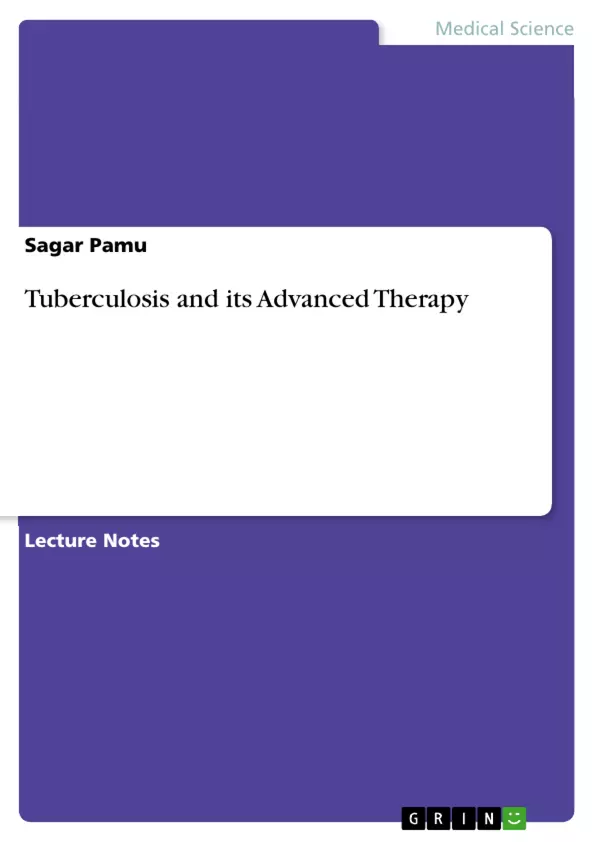Tuberculosis [TB] is an infectious disease that can affect any part of the body, mainly an infection of the lungs.
In a Neo-Latin word, tuberculosis is termed as ‘TUBERCLE’ which means round nodule and ‘OSIS’ which means condition.
The causative organism for tuberculosis is Mycobacterium tuberculosis in human and Mycobacterium bovis in animals. Mycobacterium tuberculosis is small, aerobic, nonmotile bacillus. The other causative organisms are Mycobacterium africanum and Mycobacterium microti. The non-mycobacterium genuses are Mycobacterium leprae, Mycobacterium avium, Mycobacterium asiaticum. The M.Tuberculosis complex consists of M.africanum, M.bovis, M.canetti, and M.microti.
According to WORLD HEALTH ORGANISATION (WHO), in 2012 they estimated around 8.6 million cases in which women were found approximately around 2.9. Most cases were found in Africa (27%) and Asia (58%), with the highest incidence in India (2.0-2.4 million), China (0.9-1.1 million); and total accounted the number of cases is 38%.
Inhaltsverzeichnis (Table of Contents)
- Introduction
- Epidemiology
- Pathogenesis
- Types of tuberculosis
- Diagnosis
- Management of tuberculosis
- Treatment duration and comments
- Isoniazid drug information
- Rifampicin drug information
- Pyrazinamide drug information
- Ethambutol drug information
- Streptomycin drug information
Zielsetzung und Themenschwerpunkte (Objectives and Key Themes)
This text aims to provide a comprehensive overview of tuberculosis, covering its epidemiology, pathogenesis, diagnosis, and management. It delves into specific drug information for common treatments. The focus is on providing a structured understanding of this infectious disease.
- Epidemiology and prevalence of tuberculosis globally.
- Pathogenesis and classification of tuberculosis.
- Diagnosis and management strategies for tuberculosis.
- Detailed information on key anti-tuberculosis drugs.
- Risk factors associated with tuberculosis infection.
Zusammenfassung der Kapitel (Chapter Summaries)
Introduction: This chapter introduces tuberculosis as an infectious disease primarily affecting the lungs. It defines the term "tuberculosis" and identifies the causative organisms, including *Mycobacterium tuberculosis* in humans and *Mycobacterium bovis* in animals. The chapter also briefly mentions other causative organisms and provides a classification of tuberculosis, differentiating between pulmonary and extra-pulmonary forms. The introduction lays the groundwork for a deeper understanding of the disease's nature and scope, establishing the fundamental information needed to comprehend the subsequent sections focusing on epidemiology, pathogenesis, diagnosis, and treatment.
Epidemiology: This chapter presents epidemiological data on tuberculosis, citing World Health Organization (WHO) statistics from 2012. It highlights the global distribution of the disease, with a concentration in Africa and Asia, particularly India and China. The chapter analyzes trends in incidence, prevalence, and mortality rates over time, noting fluctuations and attributing some changes to factors such as HIV co-infection and the introduction of the DOTS strategy. The discussion also explores several risk factors associated with tuberculosis, such as HIV infection, chronic lung disease, silicosis, smoking, and close contact with infected individuals. This section provides a vital context for understanding the public health challenges posed by tuberculosis and the significance of effective prevention and control measures.
Schlüsselwörter (Keywords)
Tuberculosis, Mycobacterium tuberculosis, Epidemiology, Pathogenesis, Diagnosis, Management, Treatment, Isoniazid, Rifampicin, Pyrazinamide, Ethambutol, Streptomycin, Risk factors, Public health.
Tuberculosis: A Comprehensive Language Preview - Frequently Asked Questions
What information is included in this language preview?
This preview provides a comprehensive overview of tuberculosis, including the table of contents, objectives and key themes, chapter summaries, and keywords. It offers a structured and detailed look at the disease, covering its epidemiology, pathogenesis, diagnosis, management, and the specifics of common anti-tuberculosis drugs.
What are the main topics covered in the text?
The text covers various aspects of tuberculosis, starting with an introduction to the disease and its causative agents. It then delves into the epidemiology of tuberculosis, its pathogenesis, different types of the disease, diagnostic methods, management strategies, treatment duration, and detailed information on key anti-tuberculosis drugs such as Isoniazid, Rifampicin, Pyrazinamide, Ethambutol, and Streptomycin.
What are the key objectives and themes of this text?
The main objective is to provide a thorough understanding of tuberculosis. Key themes include the global epidemiology and prevalence of tuberculosis, its pathogenesis and classification, effective diagnosis and management strategies, detailed information on key anti-tuberculosis drugs, and associated risk factors. The focus is on providing a structured and comprehensive understanding of this infectious disease.
What is covered in the chapter summaries?
The chapter summaries provide concise overviews of each section. The introduction defines tuberculosis and its causative organisms. The epidemiology chapter presents global distribution, incidence, prevalence, and mortality rates, highlighting risk factors. Further chapters detail pathogenesis, diagnosis, and management, including information on specific drugs.
What are the key words associated with this text?
Key words include Tuberculosis, Mycobacterium tuberculosis, Epidemiology, Pathogenesis, Diagnosis, Management, Treatment, Isoniazid, Rifampicin, Pyrazinamide, Ethambutol, Streptomycin, Risk factors, and Public health.
What is the target audience for this text?
While not explicitly stated, the comprehensive and detailed nature of the preview suggests the text is intended for academic or professional use, possibly for medical students, healthcare professionals, or researchers studying infectious diseases.
Where can I find the complete text?
The provided preview does not specify where the complete text can be found. Further information would be needed to locate the full publication.
What is the significance of the information on anti-tuberculosis drugs?
The detailed information on Isoniazid, Rifampicin, Pyrazinamide, Ethambutol, and Streptomycin is crucial for understanding treatment strategies and the management of tuberculosis. This information is likely important for healthcare professionals involved in the diagnosis and treatment of the disease.
- Arbeit zitieren
- Dr. Sagar Pamu (Autor:in), 2018, Tuberculosis and its Advanced Therapy, München, GRIN Verlag, https://www.grin.com/document/423950



